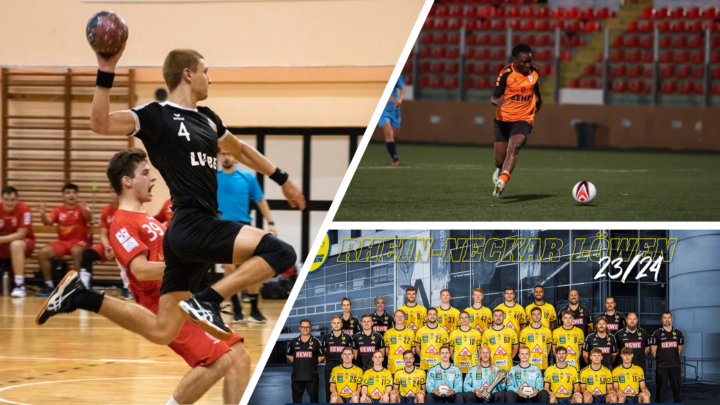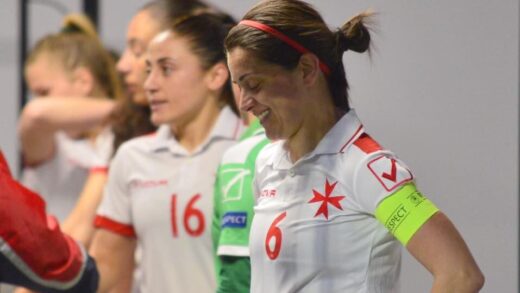The collection of kits is a major part of sports culture. However, there is a lot that goes into making a kit for the team who will be taking to the pitch. Having the right fit, style and quality to take the gruelling conditions of sport requires plenty of thought and effort. Besides that, the fixed dates of a season launch mean that there is no room for error on a kit delivery.
The Sporting Fan decided to speak with ERIMA’s Head of International Business, Matthias Moosmayer, about the German sportswear manufacturer who has recently made a full circle with teams in Malta.
Disclaimer: This is not a sponsored article and there are no affiliate links.
ERIMA’s History In Sport & Early Connection To Malta
ERIMA has a history of more than 120 years, having been founded in 1900. The 1960s to the 1980s made ERIMA a household name in Germany, after several athletes donned their clothing as they took to podiums in the Olympics. It was the supplier for all German athletes in each Olympic Games between 1960 and 1972.
Additionally, in those times ERIMA became essentially the sole supplier of football kits for the teams playing in the Bundesliga, from Bayern Munich, to Schalke 04, Cologne, Eintracht Frankfurt and more. It was the kit manufacturer of the German national team as they lifted the World Cup in 1974.
At this point, Erich Mak decided to sell the company to Adidas, to whom taking over ERIMA provided a new market. During this period, the company was also producing kits for the Malta men’s national team, and in fact it was the kit provider for both national teams when Malta and Germany clashed heads at the Empire Stadium in Gzira in 1979. This marked an early chapter in the relationship between the company and the island of Malta.

The 1990s were a tougher period for the company under Adidas, at a time when the textiles industry manufacturing started to be moved into Asia. In this regard, the business model for ERIMA was under pressure, at which point the current ERIMA owner, Wolfram Mannherz, was the marketing manager at Adidas. He started taking over slowly until he took complete ownership of ERIMA in 2005.
What The Company Stands For Today
Since then, ERIMA has been focusing on teamsport. In football, it continued to produce kits for Cologne, Dynamo Dresden, Eintracht Braunschweig and many more. It also returned as the kit sponsor for German national teams participating in canoeing, shooting and modern pentathlon in the Rio Olympics in 2016.
In speaking with the Head of International Business, Matthias Moosmayer, we discussed how past experience with Adidas has shaped who ERIMA is today. “The big change was to really focus on the needs of teams. We’re not a lifestyle brand, we don’t focus on fashion, we focus on what a team needs.”
Moosmayer explained that to ERIMA this is represented by three main factors, “All our collections are available for four years. So, if a club designed a kit and next year they have new members or want to replace some, they can keep ordering for four years from us. So whereas the market is focused a lot on fast fashion, we are super slow fashion. It means we really support the teams, which helps them reduce cost and also is more sustainable than forcing them to change kits every year, like maybe some of the bigger brands would. We also cater for kids, women and men. So, the club can really have the same outfit for all and we have around eleven colours which really allows us to cater for all teams.”
He also noted that the company is also not just solely focused on football, but it caters for all team sport. “Some clubs have ten divisions of sport and our collections allow us to support the club for all these teams.”
The Nuances of Kit Design
The company does not only focus on the aesthetic design of their kits but develops materials to cater for the needs of the sport. Questioned about this, Moosmayer said, “Our development team in Germany takes care of both the aesthetic and the design of the fabric.”
Each sport brings its own set of conditions and requirements. Questioned about the effect of this on their operations in being able to cater for each need, Moosmayer said, “Yes, for sure a footballer for example has very different needs in terms of the fabric to someone playing handball or maybe tennis. For example, in tennis you may focus more on flexibility in the fabric, whereas in handball you need tougher material.”
He also noted, that over time the company also adapted to ensure quality but also streamline its processes, “I remember when I started with ERIMA there was a separation in the jerseys produced specific for football and some for handball. However, some clubs then started to ask us for the same material for the other sports, so we decided to make all our jerseys strong enough for handball, because if they are strong enough for that, they are strong for football.”
The Process of Designing A Kit With A Team
Asked about the process of creating a new kit with a club, he said, “If you start designing a new kit in winter then it is great because there is less demand since it is a seasonal business. This is because when you consider the design process, it would allow us to do the first sketches in November-December and get it approved by the sponsors. We would then be able to make a sample and get it checked by the team, make any adjustments and then have the design ready in March. At that point, the club would be able to make the order and have it with them in May. That means that you have everything ready before the new season even starts.”
He noted that this would be the ideal scenario but that they often face the other extreme, “Of course, if you start thinking about a new design in May and want it ready in July, it will be super tough! We still try to get it done but it requires a lot of communication. We generally ask the clubs to prepare for two-week extra for the delivery because there is always something that comes up since there are a lot of moving parts. Having these two-weeks as cushion is important to ensure that they have the kits on the season launch.”
In relation to this, The Sporting Fan asked how the company goes about working with a new club to design their first kits. Matthias Moosmayer said, “First we want to understand their requirements, what is important for them in terms of design. So, what are the colours, the elements of the club, and do they look for a detailed design or a minimalistic one. Understand what they had before, what they liked and did not like about it. We also try to get some feedback to understand what they are looking for. From then we start the design process.”
Delivering To The Demand Of The Sport
There is no doubt that football is one of the major sports in the world, with exceptional popularity in Europe. Companies like Nike and Adidas, among other big brands, hold major pull on several top clubs in football but also in other sports. However, companies which drive such high volumes are often not an ideal candidate for smaller clubs, of which there are many. One obvious reason would be that these smaller clubs are not likely to be interested in procuring such high volumes of kits and merchandise.
However, when talking about demand, volume is not the only thing that matters. There is no doubt that no matter how small, having a bespoke kit that is representative of the club is a crucial aspect to the identity. Asked about this, Moosmayer noted that the demand for this individuality is increasing and that with time it is likely that all clubs will want to have that unique design to differentiate themselves from other clubs.
This is one aspect where a company like ERIMA differentiates itself. Moosmayer noted that ERIMA aims to give these smaller clubs an opportunity to design a unique kit and be willing to produce a small number of it. He said, “We can produce jerseys starting from ten to fifteen pieces with a completely individual design, logo and detail. We have a design team dedicated for this and an online tool (you can check it out for yourself here) which enables clubs to create their own jerseys and we produce them within six to eight weeks for them. If you consider the price including printing, which can be quite expensive because there may be many sponsors, it is still not too much more expensive than a jersey from the catalogue.”

Additionally, Moosmayer noted that they offer this flexibility while also being equipped to scale up to higher quantities. “If the club is a bit bigger, something like an association or an Olympic team, then we can also produce the items completely individually for them. This also includes merchandise.”
Noting this flexibility and the seasonal nature of the sport, one of the questions that crops up is the ability to deliver these custom kits in time for a season launch. Asked about this, Moosmayer said, “This is one of the things that we are famous for in the team sport industry. Our warehouse was opened 2019 and is state of the art top model. It allows us to have approximately 3.5 million items on stock.”
Asked about how they plan out these schedules, he continued, “We know more or less the items we need during the year but also to be able to meet the high-peak demand at the season launches. Like this, we can really schedule the delivery times and in fact the normal lead time for us is just one or two days to have the products ready in the warehouse in Germany. It is only the shipping part that takes longer. For example, delivering to Malta of course takes a bit longer because it is an island, when compared to for example delivering to Germany or to Austria. However, because we are like also the warehouse for our customers it gives us the ability to really deliver in a short time. We saw this even during Covid-19 times, where despite having additional hurdles, we were still able to deliver in relatively good time.”
Those involved in the daily running of a club know that the need for new kits is not only something that crops up at the beginning of a season, and often this is not in a neatly planned schedule. Asked about this, Moosmayer noted that having worked with plenty of teams over the years, this is something that they are well aware of, “This ability to deliver throughout the year and have this flexibility is what you need to have with team sports. If it is just a matter of getting maybe a new design, then that is one thing. However, throughout the season many things can happen, kits get worn, lost or maybe there’s a new player coming in. This is when the pressure is on for the clubs especially if there is a match coming up in a few days. It is important for us to be able to provide these kits to them so they can compete.”
Additionally, he noted that even when designing a new kit, there are always last-minute detail changes, “You can plan everything for the season launch, but it does not work all neat and perfect, because there is always some late change in the sponsor, new players, new opinion on some small detail. Because of this you need to be quick in the process to be able to handle these changes, since of course everyone is excited and wants the new product yesterday, not in four weeks!”
Customising Aesthetics & Fits For All Teams
Several clubs today have both men’s and women’s sides which means that flexibility also extends to different fits and sizes. Additionally teams range from those of very young children in academies to senior competitive athletes.
Asked about the capability to handle these different requirements, Moosmayer replied positively, “If you order a tracksuit for example, you can decide different sizes for the pants and the top. You can decide whichever combination you want in terms of fit. For example, we know that not all women want a slim or curved fit so we also offer the ability to buy also the straight fit, so that everyone feels comfortable. Another aspect is that we are aware that people in different countries do not have the same body shape or height, so this ability to mix and match fits is very important to us to be able to give everyone a comfortable fit.”
He also noted that the company provides the ability to combine different collections. “This is good because are always improving our ability to offer things in all the colours, so you can really combine the different collections in the way that you want. Additionally, if we have for example a new collection coming out in 2024, this means that you can slowly introduce this new design and combine it with the 2023 collection for example. It means that a club can slowly change the kit and is not forced to make a big change all the time.”
The Relationship With Malta
ERIMA has major hubs across Europe, including Austria, France and Germany, among others. As noted above, it’s relationship with Malta existed before but has recently resurfaced through its work with Swieqi United football teams, the Swieqi Phoenix Handball Club and Hamrun Handball Club, among others.
Asked about the experience in working with the local teams in Malta as compared to clubs in other countries, he noted, “There is always a difference in perhaps culture, working hours and also the structure. The hap-hazard nature of the work is something that you experience because of the nature of sports in general, so we experience this with everyone. However, I would say that from my experience Maltese people are very passionate and very professional. It’s been great so far.”
Those interested about learning more can find more information about ERIMA here and ERIMA Malta here.
The Sporting Fan would like to thank Matthias Moosmayer for his time to bring you this special feature.
Thank you for reading. If you enjoyed this, consider sharing it with a friend who you think will enjoy it.
Lead Images: ERIMA / ERIMA Malta / Michael Azzopardi
Stay up to date by following The Sporting Fan on social media: Instagram ~ Facebook ~ X



